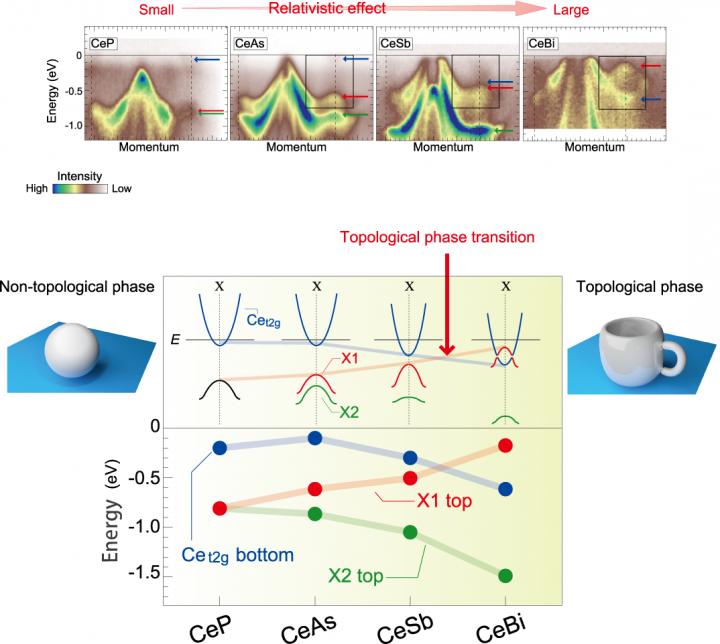Direct observation of topology hidden inside materials

These are electronic structures of Ce monopnictides which observed by soft X-ray angle-resolved photoemission spectroscopy, and its topological phase transition. Credit: © 2018 Kenta Kuroda
Topology hidden inside materials in the matter group called cerium monopnictides has been determined for the first time in the world.
The topological electronic phase distinguished by the latent topology inside materials is the award-winning subject of the Nobel Prize in Physics 2016, research on which is now being actively conducted all over the world.
In the topological electronic phase, an electronic state peculiar to the topological electronic phase occurs at the surface of materials (appearance), reflecting topology hidden inside materials (substances). For this reason, topology of a substance has been judged only by its appearance.
A joint research group succeeded in observing the topological phase transition in which a material changes to the topological electronic phase by using soft X-rays, light suitable for determining the topology of materials by their substances rather than by their appearance.
Since this research achievement enables direct determination of the essential topology hidden inside materials without judging the surface of the materials, it is expected that employing this technique will lead to the discovery of more diverse topological electronic phases.
###
This result was achieved by the research group of Assistant Professor Kenta Kuroda and Associate Professor Takeshi Kondo of the Institute for Solid State Physics, the University of Tokyo (Director Masashi Takigawa), in collaboration with Team Leader Ryotaro Arita (RIKEN Center for Emergent Matter Science), Assistant Professor Masayuki Ochi (the Graduate School of Science, Osaka University), Senior Scientist Takayuki Muro (Japan Synchrotron Radiation Research Institute), Deputy Director-General Hideyuki Kitazawa (National Institute for Materials Science) and Principle Researcher Yoshinori Haga (Japan Atomic Energy Agency).
Osaka University was founded in 1931 as one of the seven imperial universities of Japan and now has expanded to one of Japan's leading comprehensive universities. The University has now embarked on open research revolution from a position as Japan's most innovative university and among the most innovative institutions in the world according to Reuters 2015 Top 100 Innovative Universities and the Nature Index Innovation 2017. The university's ability to innovate from the stage of fundamental research through the creation of useful technology with economic impact stems from its broad disciplinary spectrum.
Website: http://resou.
Media Contact
All latest news from the category: Materials Sciences
Materials management deals with the research, development, manufacturing and processing of raw and industrial materials. Key aspects here are biological and medical issues, which play an increasingly important role in this field.
innovations-report offers in-depth articles related to the development and application of materials and the structure and properties of new materials.
Newest articles

A ‘language’ for ML models to predict nanopore properties
A large number of 2D materials like graphene can have nanopores – small holes formed by missing atoms through which foreign substances can pass. The properties of these nanopores dictate many…

Clinically validated, wearable ultrasound patch
… for continuous blood pressure monitoring. A team of researchers at the University of California San Diego has developed a new and improved wearable ultrasound patch for continuous and noninvasive…

A new puzzle piece for string theory research
Dr. Ksenia Fedosova from the Cluster of Excellence Mathematics Münster, along with an international research team, has proven a conjecture in string theory that physicists had proposed regarding certain equations….



